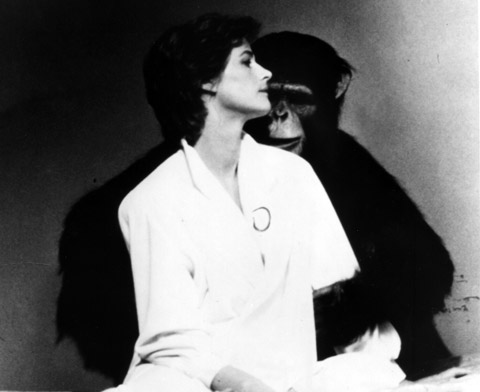
Was Charlotte Rampling’s dalliance in Max, mon amour the logical extension of Kong and Fay Wray’s forbidden love? |
Once again, Hollywood is making monkeys of us.Rise of the Planet of the Apes, which opens this weekend, marks the seventh in the canon of Ape movies that began with Franklin Schaffner's classic 1968 adaptation of Pierre Boulle's novel Planet of the Apes, a film immortalized by its haunting final image and Charlton Heston's line, "Take your stinking paws off me, you damned dirty ape!"
>> CHART: A Family Tree of Monkey Movies <<
Popular as it once was, the franchise seemed to have gone extinct after Tim Burton's 2001 debacle of a remake. Rise hopes to revive the series by resorting to the now-familiar ploy of the prequel, used most recently by X-Men: First Class and Captain America: The First Avenger. It returns to the origins of the story, explaining how apes usurped the human race to become rulers of the world.
But Rise does more than rehash a once-successful premise. It taps into one of the oldest of Hollywood traditions, one that dates back at least as far as the 1918 silent film, Tarzan of the Apes. For nearly a century apes have haunted the screen, and the link between man and ape has obsessed filmmakers. During that time apes have embodied both the best and worst aspects of humanity, from paragons of virtue to epitomes of evil, from symbols of harmony with nature to agents of environmental disaster. To explore the evolution of the ape archetype from its first appearance on the screen to its most recent development, we've devised the chart — a family tree of movie primates, descending from two main branches, one "More Mild than Wild (Monkey See)," the other "More Likely To Go Bananas (Monkey Don't)."
Me Cheeta, you Tarzan
It all begins with the prelapsarian paradise of the aforementioned 1918 Tarzan of the Apes. The first of many adaptations of the Edgar Rice Burroughs novel about a child raised by apes who would become a "noble savage," at one with his fellow primates, the film opens with the juvenile Tarzan romping stark naked with his simian playmates. In these less innocent times, the sequence might be construed as child pornography.
Followed by Tarzan the Ape Man (1932), the tale inspired scores of movies and will endure until at least 2013, when Warner Bros. plans to release a new version. Meanwhile, other "Simple Simians" films paralleled the Tarzan-Cheeta prototype, often with stories that degraded both the human and primate participants. They included Ronald Reagan and Bonzo the lab chimp in Bedtime for Bonzo (1951); Clint Eastwood and Clyde the orangutan in Every Which Way but Loose (1978) and in Any Which Way You Can (1980); and most recently, The Hangover, Part II, in which the only character to escape with any dignity intact is Crystal the cigarette-smoking capuchin monkey.
But despite this fraternization, all was not rosy in movie-monkey-land. In the same year that Tarzan the Ape Man was released, the man-ape relationship took a fall in Murders in the Rue Morgue (1932). Based loosely on the Edgar Allan Poe story, this moody thriller features a homicidal orangutan perverted into its criminal behavior by a mad scientist.